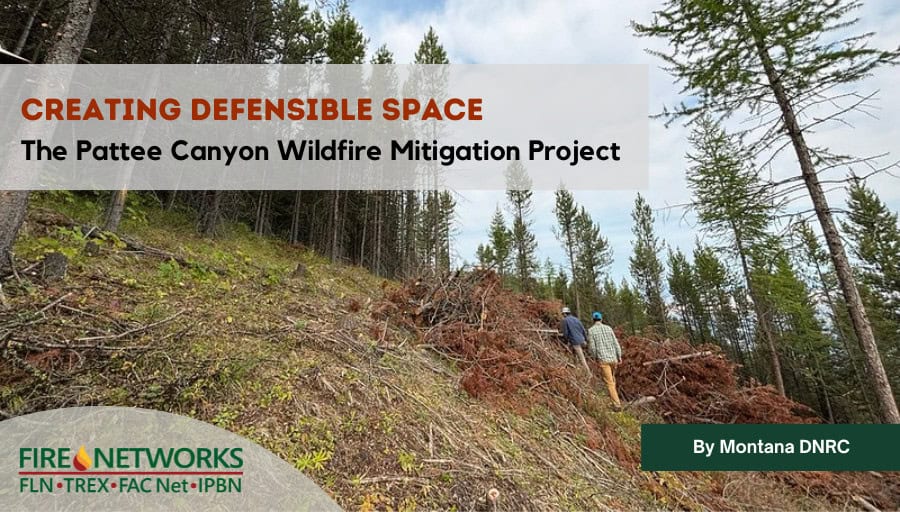Editor’s note: The Montana Department of Natural Resources and Conservation (DNRC) is committed to ensuring Montana’s land and water resources provide benefits for present and future generations. This story was originally published by the DNRC in October 2025 as part of the agency’s series of Montana Forest Action Plan project highlights. To learn more about the Forest Action Plan and read about other projects, visit DNRC’s Montana Forest Action Plan page. All images in this blog post are credited to the DNRC.
During the 2025 wildfire season to date, there have been an estimated 27 wildfire starts within 10 miles of Pattee Canyon in southeast Missoula. Since 2021, there have been an estimated 405 starts in the region, burning a total of 4,889 acres.
Thanks to swift and effective initial attack efforts between The Department of Natural Resources and Conservation (DNRC), the United States Forest Service (USFS), local fire departments, and other county cooperative program partners, these fire starts were contained before they threatened lives and property.
These starts occurred in an area similar to many other beloved multi-purpose landscapes in Montana. Pattee Canyon houses year-round residences, critical communications infrastructure, recreational trails and habitat conservation areas for elk and other wildlife.
Pattee Canyon is a high priority area of focus as identified by the Montana Forest Action Plan due to its significant forest health concerns and wildfire risk to communities and infrastructure. It is also within a high-to-very high wildfire risk area within the Missoula County Community Wildfire Protection Plan.
“A fire in Pattee Canyon would put all of these values at risk,” warns Bill Burdick, DNRC service forester. “Every fire start serves as a reminder of the urgency of wildfire mitigation work in this area.”

In the summer of 2023, in anticipation of more severe wildfire seasons, DNRC awarded a state-funded Forest Action Plan grant to the City of Missoula and Missoula County, initiating the Pattee Canyon Wildfire Mitigation project.
Working alongside its partners, DNRC outlined key objectives: Work collaboratively across property lines to implement hazardous fuel reduction treatments to reduce wildfire risk.
Since 2020, the City of Missoula’s Conservation Lands program has been implementing thinning treatments in the lower portion of Mount Dean Stone. In 2023, Forest Action Plan grant funding administered through DNRC allowed the city to tackle an additional 44 acres of treatment in priority areas, according to Peter Whitney, the city’s conservation lands program specialist.
The process of thinning creates defensible space, a buffer that limits fire spread and vastly increases a structure’s chance of survival during a wildfire event. In Pattee Canyon, creating space around the communication towers atop Mount Dean Stone is imperative for the tens of thousands of people across the Missoula and Bitterroot Valleys who rely on the towers’ connectivity for public communication as well as increasing the abilities for firefighters to safely respond to fires. Thinning also improves forest health, benefiting wildlife and recreationalists.
“Our aim is to ensure the Mount Dean Stone Preserve’s forests are resilient and resistant to the impacts of pests, pathogens and extreme wildfire events while continuing to provide a haven for wildlife and recreation.”

Meanwhile, Missoula County is making strides in assisting private landowners to reduce fire risk on 54 acres within lower Pattee Canyon.
Through the Forest Action Plan grant, Missoula County is administering a hazardous fuel reduction cost-share program, where landowners are responsible for just 25% of the project cost. Across ten projects, local contracted foresters are working with landowners in a “front-door-to-forest” approach, prioritizing the removal of fuels closest to structures before working outwards.
Greg Larson is one of the ten landowners who is creating defensible space around his property and home, one step at a time. Following the home ignition zone model, he started by targeting the area immediately surrounding his home, clearing out ignitable debris and building materials. Now, he is thinning the forest throughout his five-acre property, prioritizing more wildfire resilient species like ponderosa pine and western larch.

“I appreciate having some agency in my property’s wildfire risk,” said Larson. “I’ve given my house a chance to survive in the event of a wildfire. I’ve made it safer for firefighters to come up and protect my home and my neighbors’ homes.”
Earlier this year, the county held a community chip day where Larson and neighbors cut and chipped trees along their road to create a fuel break, further improving safety in the neighborhood. Final thinning, removal and pile burning activities are slated for fall of 2025.
The Pattee Canyon Wildfire Mitigation Project represents a crucial piece of a larger, cross-boundary effort across neighboring state and federal lands. On nearby state trust land, DNRC’s Missoula Unit completed a 108-acre timber sale in 2018, removing mistletoe-infested Douglas-fir and retaining fire-resilient western larch. Meanwhile, the Missoula Ranger District has been implementing fuel and prescribed burning projects in the Lolo National Forest for more than two decades and will continue improving forest health through the Wildfire Adapted Missoula project. These efforts on the Lolo National Forest are further supported by DNRC’s Good Neighbor Authority (GNA) program, which has recently accelerated the pace of forest treatments with hundreds of acres of thinning and mastication completed or underway this year through Forest Action Plan funding and strong collaboration between DNRC and the United States Forest Service.
“The Pattee Canyon Wildfire Mitigation project is a classic cross-boundary project, wherein private landowners and state, federal and tribal entities all work together toward a common goal,” said Burdick. “Everybody’s doing their part. We’re all trying to reach the same outcome.”
****


Great work by the folks at DNRC and appreciate this type of reporting.